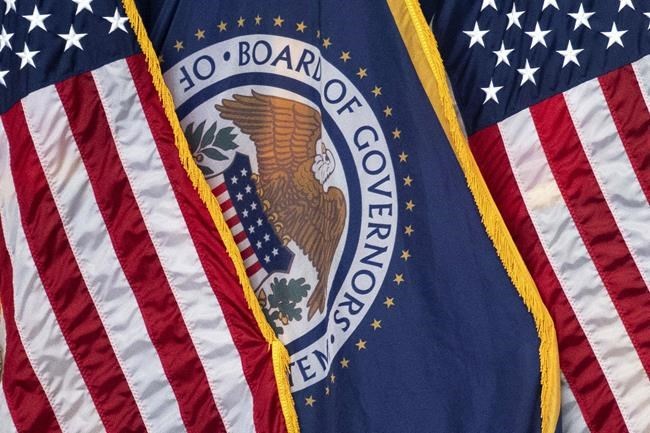
File - The flag of the Federal Reserve hangs between American flags at a news conference following a Federal Open Market Committee meeting on July 26, 2023 in Washington. On Wednesday, the Federal Reserve releases minutes from the July meeting when it raised its benchmark borrowing rate by another quarter point to 5.4%, the highest level in 22 years. (AP Photo/Nathan Howard, File)
Republished August 16, 2023 - 12:20 PM
Original Publication Date August 16, 2023 - 11:11 AM
WASHINGTON (AP) — Most Federal Reserve officials last month still regarded high inflation as an ongoing threat that could require further interest rate increases, according to the minutes of their July 25-26 meeting released Wednesday.
At the same time, the officials saw “a number of tentative signs that inflation pressures could be abating." It was a mixed view that echoed Chair Jerome Powell's noncommittal stance about future rate hikes at a news conference after the meeting.
According to the minutes, the Fed's policymakers also said that despite signs of progress on inflation, it remained well above their 2% target. They “would need to see more data ... to be confident that inflation pressures were abating” and on track to return to their target.
At the meeting, the Fed decided to raise its benchmark rate for the 11th time in 17 months in its ongoing drive to curb inflation. But in a statement after the meeting, it provided little guidance about when — or whether — it might raise rates again.
Most investors and economists have said they believe July's rate hike will be the last. Earlier this week, economists at Goldman Sachs projected that the Fed will actually start to cut rates by the middle of next year.
Since last month's Fed meeting, more data has pointed in the direction of a “soft landing,” in which the economy would slow enough to reduce inflation toward the central bank’s 2% target without falling into a deep recession. The Fed has raised its key rate to a 22-year high of about 5.4%.
Inflation has cooled further, according to the latest readings of “core” prices, a category that excludes volatile food and energy costs. Core prices rose 4.7% in July a year earlier, the smallest such increase since October 2021. Fed officials closely track core prices, which they believe provide a better read on underlying inflation.
Overall consumer prices rose 3.2% in July compared with a year earlier, above the previous month’s year-over-year pace because of higher gas and food costs. Still, that is far below the peak inflation rate of 9.1% in June 2022.
That progress has been made without the sharp increase in unemployment that many economists had expected would follow the Fed’s sharp series of interest rate hikes, the fastest in four decades. The unemployment rate actually ticked down to 3.5% in July, near the lowest level in a half-century.
Hiring has slowed, however, with employers having added 187,000 jobs in July, a solid gain but roughly one-third of the pace of monthly job growth earlier this year.
Still, the Fed now faces upticks in gas and some food prices, which could keep overall inflation from falling much further in the coming months. And rising costs for services, from auto insurance to restaurant meals to dental services, could keep core inflation persistently high.
In a sign that at least some officials think the Fed is nearing the end of its rate hikes, the minutes said “a number” of policymakers think their benchmark rate is high enough to restrain the economy.
These officials also think the risk of raising rates too high is roughly equal to the risk of not raising them high enough. That marks a significant shift from earlier this year, when the Fed routinely said the main risk was tilted toward not doing enough to slow borrowing and spending.
Data this week suggests that the economy, if anything, is picking up, which could keep inflation sticky at its current elevated level. Consumers are still spending at a healthy pace. A report Tuesday showed that retail sales rose faster than expected last month, fueled by rising online shopping and healthy sales at restaurants and bars, among other categories.
The strong sales figures “suggest a much more robust underpinning to the economy, certainly not what the Fed wants to see” as it seeks to slow inflation, said Quincy Krosby, chief global strategist for LPL Financial.
The Fed’s decision in July to raise rates for an 11th time was unanimous, a sign that the officials remain largely unified even as their decisions become more fraught. The minutes, though, said that two officials favored keeping the Fed’s rate unchanged last month, out of the 18 that took part in the meeting. At least one or both could be among the officials who lacked a vote last month. Only 11 officials currently vote on the Fed's rate policies.
Since the meeting, Fed officials have expressed contrary views. On Tuesday, Neel Kashkari, president of the Federal Reserve Bank of Minneapolis, said he wants the Fed to keep its options open for another rate hike.
“I’m not ready to say that we’re done, but I’m seeing positive signs that say, hey, we may be on our way,” Kashkari said. “We can take a little bit more time and get some more data in before we decide whether we need to do more.”
By contrast, Patrick Harker, president of the Philadelphia Fed, said he would support leaving rates unchanged for the rest of this year.
“Absent any alarming new data between now and mid-September," Harker said, “I believe we may be at the point where we can be patient and hold rates steady.”
News from © The Associated Press, 2023